It was time for another Chelsea gallery slog. I'd missed too many openings I wanted to see; there was nothing else to do but set aside a day to go from gallery to gallery. There were shows I simply couldn't miss, paintings I had to see for myself.
My partner in this venture was Stephanie Lee Jackson, also known as Serena. (Online she's more of a Serena than a Stephanie; in real life, she's more of a Stephanie. Serena has some sharp corners and rough spots, but Stephanie is pleasant and less serious.) She made the mistake of agreeing with me across a few blog comments and I liked her writing on her blog, so she got invited. Some of the shows on my list overlapped with shows on hers so she accepted. We met at the Empire Diner, a landmark so obvious tour buses stop there for photos; then we started at the bottom end of Chelsea, 18th Street, and worked our way uptown to 27th.
Our odyssey began at Bellwether Gallery with
the Clayton Brothers
More than one person has asked me what I know about the Clayton Brothers: Is there more than one person really? Are they really brothers? As near as I can tell there are two of them and they are, in fact, brothers. But I don't really know them, either. One thing I know for sure is that they're angry about something. You can tell from their paintings. They're just obviously pissed off. About what I have no idea.
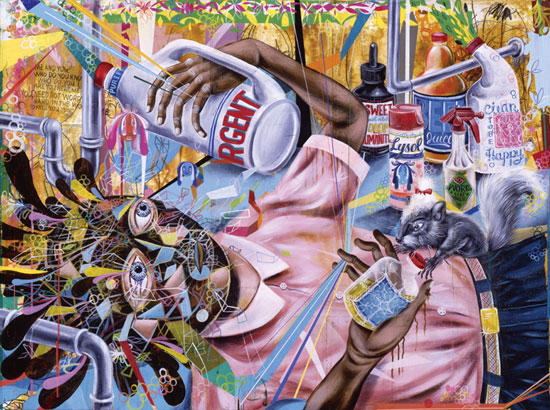 Their current show at Bellwether tackles a very important subject too often ignored by mainstream art: Laundry. The show is titled Wishy Washy, just in case you couldn't tell from all the Pop Art-inspired boxes of Tide and bottles of Clorox and, you know, washing machines. And Lysol, although what Lysol has to do with laundry I am unsure. In case the clothes washing doesn't quite get through to you, though, the little laundromat installation in the middle of the main room will bring it home to you. As usual, I can't tell what the Clayton Brothers really feel; they seem angry, as I said, but in a very non-specific way. I don't think they're angry at people who do laundry, but maybe they're mad about the very fact that anyone has to do laundry; I find their paintings totally opaque. Everything seems weighted with some kind of symbolism but the meaning is unclear to me. And as the great sage Roger Ebert teaches us in his Law of Symbolism: If you have to ask what something symbolized, it didn't. What are we to make, for example, of the numerous squirting eyedroppers being wielded in several of the paintings? The obvious thing is to say they're phallic symbols. But then what? Whose phalluses? Why?
Their current show at Bellwether tackles a very important subject too often ignored by mainstream art: Laundry. The show is titled Wishy Washy, just in case you couldn't tell from all the Pop Art-inspired boxes of Tide and bottles of Clorox and, you know, washing machines. And Lysol, although what Lysol has to do with laundry I am unsure. In case the clothes washing doesn't quite get through to you, though, the little laundromat installation in the middle of the main room will bring it home to you. As usual, I can't tell what the Clayton Brothers really feel; they seem angry, as I said, but in a very non-specific way. I don't think they're angry at people who do laundry, but maybe they're mad about the very fact that anyone has to do laundry; I find their paintings totally opaque. Everything seems weighted with some kind of symbolism but the meaning is unclear to me. And as the great sage Roger Ebert teaches us in his Law of Symbolism: If you have to ask what something symbolized, it didn't. What are we to make, for example, of the numerous squirting eyedroppers being wielded in several of the paintings? The obvious thing is to say they're phallic symbols. But then what? Whose phalluses? Why?
 The laundromat installation is completely superfluous. I don't know if it's there to pad their resume or maintain some kind of Conceptual Artist membership, but it's not especially interesting, except in bringing up those practical questions I love to ask: Does the gallery give the artist a budget for this kind of thing, or does the artist save up to pay for it themselves? Where does it go when the show is over? Are there collectors who buy these things and put them in their living rooms? Stephanie said it was very nearly a rip-off of another artist who apparently does these kinds of things all the time; I forget the name. It doesn't really matter to me. I don't think it's worth attempting to assign blame for installations.
The laundromat installation is completely superfluous. I don't know if it's there to pad their resume or maintain some kind of Conceptual Artist membership, but it's not especially interesting, except in bringing up those practical questions I love to ask: Does the gallery give the artist a budget for this kind of thing, or does the artist save up to pay for it themselves? Where does it go when the show is over? Are there collectors who buy these things and put them in their living rooms? Stephanie said it was very nearly a rip-off of another artist who apparently does these kinds of things all the time; I forget the name. It doesn't really matter to me. I don't think it's worth attempting to assign blame for installations.
Ultimately both Stephanie and I kind of liked the Clayton Brothers show but didn't feel very strongly about it. The work is interesting, nice to look at, not bad, but in the end nothing very exciting, either. The next gallery was totally different, at least for Stephanie; as soon as we walked into Feigen Contemporary she fell in love with the work of
Jennifer Coates
I'm afraid I have to admit Jennifer Coates' show wouldn't have been on my list if it weren't for Ed Winkleman. He posted about how much he loves her work and, because I take recommendations seriously when they come from people I respect, I put Jennifer on my list. The images of her work online don't excite me, honestly, and her style is not one I'd go out of my way for.
 But this is why I follow recommendations: I was pleasantly surprised. I found I actually do like Jennifer's work. I think the show's signature image, Two Trees -- apparently her latest painting, and the one you can see on Ed's blog entry -- is the weakest of the group; she has two larger paintings which work much better, to my eye. Each painting in this show combines vast sweeps of color with tiny, obsessive passages of great detail. And each one has vague intimations of landscape. Two Trees is the most obvious and that, to me, is a drawback. I prefer her Creeper, which has subtleties you can't make out in the reproduction: The middle section looks like an eruption of worms, boiling out of the filmy atmosphere of the place-no-place of the painting.
But this is why I follow recommendations: I was pleasantly surprised. I found I actually do like Jennifer's work. I think the show's signature image, Two Trees -- apparently her latest painting, and the one you can see on Ed's blog entry -- is the weakest of the group; she has two larger paintings which work much better, to my eye. Each painting in this show combines vast sweeps of color with tiny, obsessive passages of great detail. And each one has vague intimations of landscape. Two Trees is the most obvious and that, to me, is a drawback. I prefer her Creeper, which has subtleties you can't make out in the reproduction: The middle section looks like an eruption of worms, boiling out of the filmy atmosphere of the place-no-place of the painting.
Jennifer's paintings are all slightly unsettling, like viewing an alien world which isn't so much malevolent as simply indifferent. There's a jungly closeness to them. I like the way she moves back and forth between slapping down huge swaths of paint with a big brush and carefully dotting in tiny spirals with such care I can see the shape of the brush tip and tell when she stopped to repoint.
That said, I didn't think Jennifer's work was the most extraordinary thing I'd ever seen. Stephanie, however, stood rapt. She spent ages in front of one painting. When I had told her Jennifer's show was on my list, Stephanie said she had to go because she felt Jennifer's paintings "had something to tell" her. Stephanie therefore went to listen and listen she did, and I don't think she was disappointed. While Stephanie communed with Jennifer's art I took a wander around the rest of the gallery.
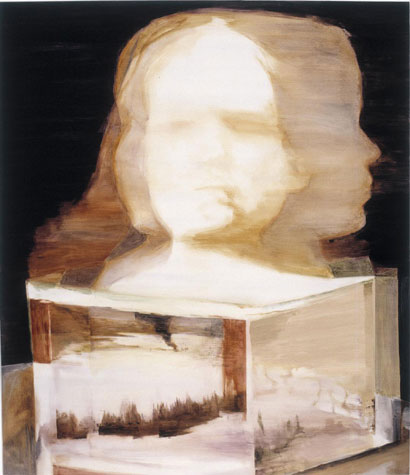 Susanne Simonson's work has the feel of a dream, in that you think there's more detail there than there really is. At a glance there's something photographic about her paintings, but when you really look, it turns out to be vague and amorphous. Some of the paint is laid on very thickly and stickily; other areas look almost like watercolors. The feeling I got was a touch of Francis Bacon, only without the anger; Bacon without anger doesn't leave much, though, and that's how I felt. There are some distant vibrations here -- puberty, childhood, being a young girl, uneasiness -- but everything is so vaporous, tentative, and indefinite; I felt like my hands were closing on smoke.
Susanne Simonson's work has the feel of a dream, in that you think there's more detail there than there really is. At a glance there's something photographic about her paintings, but when you really look, it turns out to be vague and amorphous. Some of the paint is laid on very thickly and stickily; other areas look almost like watercolors. The feeling I got was a touch of Francis Bacon, only without the anger; Bacon without anger doesn't leave much, though, and that's how I felt. There are some distant vibrations here -- puberty, childhood, being a young girl, uneasiness -- but everything is so vaporous, tentative, and indefinite; I felt like my hands were closing on smoke.
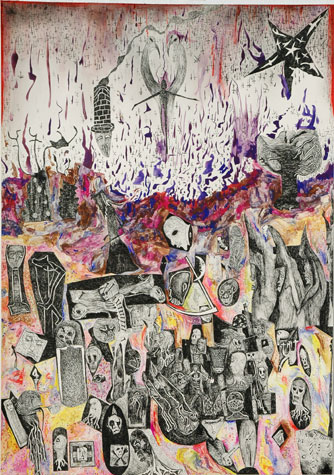
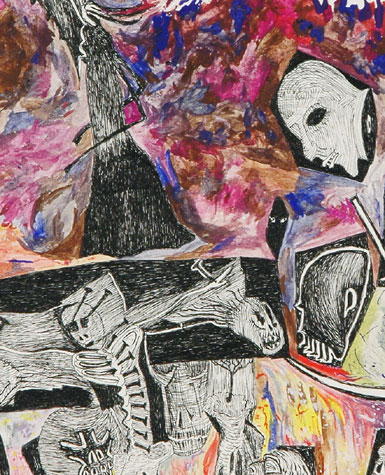 By contrast, the drawings of Nick Blinko, hiding in the back of Feigen, are intensely detailed and frenzied. And where Susanne's paintings are ambiguous, Nick's drawings are pretty clear. I guess you can't just write "RELIGION BAD" over and over, but Nick's heavy-handed use of religious imagery is close. Still, as I've mentioned more than once, I love obsessive drawing, and these drawings are pretty insanely obsessive. If ever there was someone who could wear out a 0.13mm Rapidograph, it's Nick Blinko. A couple of the drawings had so many tiny faces I had to stop looking because my brain was full. Sure, they look a little like the schoolbook of a Mexican Goth in Catholic school with ADHD, but that's not such a bad thing.
By contrast, the drawings of Nick Blinko, hiding in the back of Feigen, are intensely detailed and frenzied. And where Susanne's paintings are ambiguous, Nick's drawings are pretty clear. I guess you can't just write "RELIGION BAD" over and over, but Nick's heavy-handed use of religious imagery is close. Still, as I've mentioned more than once, I love obsessive drawing, and these drawings are pretty insanely obsessive. If ever there was someone who could wear out a 0.13mm Rapidograph, it's Nick Blinko. A couple of the drawings had so many tiny faces I had to stop looking because my brain was full. Sure, they look a little like the schoolbook of a Mexican Goth in Catholic school with ADHD, but that's not such a bad thing.
Meanwhile Stephanie was still standing agawp in front of Creeper. I managed to wake her up and get her moving again, but she just wasn't the same.
Next we went up to 23rd Street and Leo Koenig where we got a look at
Nicole Eisenman
Unfortunately, due to Edna's blog entry, I will now always think of Nicole Eisenman as being "equipped." I wanted to see Nicole's show mainly because of Edna's entry; the painting also looked interesting. The show is essentially one painting: There's some other stuff, but the main attraction is Progress: Real and Imagined, an enormous diptych, fifteen feet long and eight feet high.
 I wish someone would break up this diptych. The left side is pretty good: An artist (I assume Nicole) is surrounded by pressures and influences, including painted and unpainted pieces of canvas added collage-like to the surface of the larger painting and a big globby mess of paint meant to symbolize, I'm pretty sure, a big globby mess of paint. There's a lot of detail, some abstract passages and some realistic; there's plenty to look at and think about. Nicole's technique is good and I was drawn in.
I wish someone would break up this diptych. The left side is pretty good: An artist (I assume Nicole) is surrounded by pressures and influences, including painted and unpainted pieces of canvas added collage-like to the surface of the larger painting and a big globby mess of paint meant to symbolize, I'm pretty sure, a big globby mess of paint. There's a lot of detail, some abstract passages and some realistic; there's plenty to look at and think about. Nicole's technique is good and I was drawn in.
The right side, alas, is a repulsive wreck, more in keeping with Nicole's somewhat childish and obvious oeuvre. In a big painting with a lot going on, the most glaring vignette, to my eye, is near the lower left, where a nude woman who appears to have been shot in the head is giving birth; she is attended by two people who appear at best diffident, and the baby's head seems to be tearing apart the mother's vagina. I couldn't make out too many other details as well as that. Stuff is going on. None of it is even remotely nice. Nicole's technique is brutish here. I can't say much more beyond that because I can't make out the tiny reproduction and I didn't examine the original more closely. Some artists apparently think if they work large enough, it lends their otherwise shallow ideas some gravity. Some artists are wrong.
The rest of the work in the show is, again, more in line with Nicole's established work, which is to say messy and not very engaging. In fact I have no direct memory of any of it and Koenig's Website isn't helping. Stephanie picked up negative vibes immediately and didn't want to hang around.
We next found ourselves on my favorite street, 25th, where we started at Gallery Henoch which was showing
Stephen Wright
I'm starting to think of Gallery Henoch as the Home of Technique. The director, George Henoch Shechtman, has made his taste in painting pretty clear: He likes realism and he likes artists who can draw and paint, and he's not having any truck with abstract nonsense. This makes any visit to Gallery Henoch a good one for me because I'm always so easily seduced by academic painting.
Stephanie was drawn to the downstairs part of the gallery, for reasons beyond my understanding, so we actually started off sampling the many artists of the gallery. You can go to their Website and get an idea of what we saw; I was struck particularly by Eric Zener (whose show I already wrote about briefly) and Trey Friedman. Popliteo (Luis Montoya and Leslie C. Ortiz) had a neat sculpture of asparagus; Henry Richardson had a stack of glass plates pressed against the ceiling which I nearly tripped over.
 Eventually we made our way upstairs and to the main gallery. Stephen Wright's work is absolutely fantastic. Some of his larger figurative work (like what I'm showing here) is edging towards Lucian Freud, but with a little more humanity. Some of his other paintings are flatter and less dense. Sometimes it looks like he's working from photos; other times he's so painterly it's almost frightening. All of his work feels a little detached, as if he's capturing what someone looks like whether they like it or not. But his feel for skin and light and shadow is so emotional.
Eventually we made our way upstairs and to the main gallery. Stephen Wright's work is absolutely fantastic. Some of his larger figurative work (like what I'm showing here) is edging towards Lucian Freud, but with a little more humanity. Some of his other paintings are flatter and less dense. Sometimes it looks like he's working from photos; other times he's so painterly it's almost frightening. All of his work feels a little detached, as if he's capturing what someone looks like whether they like it or not. But his feel for skin and light and shadow is so emotional.
His drawings in the show are more informal and relaxed, almost like cartoons or caricatures. That makes me feel even more as if Stephen works from photos; the drawings are clearly done without photo references, and his anatomy is all distorted. Also, and unfortunately, he's drawn some cats.
I came away from Stephen's show wanting to be a better painter. I'd prefer to take away something more powerful, something really profound. But I'm still happy to see what human beings can accomplish when they put their minds to it. Sometimes excellent craftsmanship is enough.
Next door at Betty Cuningham we wandered in to a show which was not on my list, namely that of
Judy Glantzman
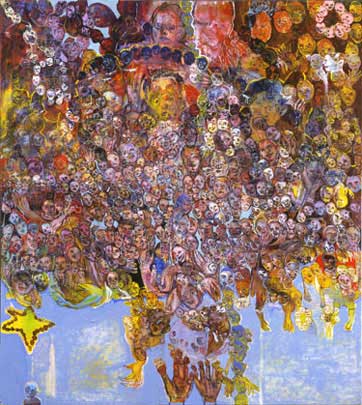 I'm sorry to say that Judy Glantzman's work is the opposite of anything you'd find in Gallery Henoch. It is, in fact, blobby, indistinct, interchangeable, forgettable work. Included in the show are a number of blobby, indistinct, interchangeable, forgettable sculptures, too. Hundreds of badly formed faces peer out of the morass of paint at us, crying out, "Save us! Free us from this blech!" But they will never be freed.
I'm sorry to say that Judy Glantzman's work is the opposite of anything you'd find in Gallery Henoch. It is, in fact, blobby, indistinct, interchangeable, forgettable work. Included in the show are a number of blobby, indistinct, interchangeable, forgettable sculptures, too. Hundreds of badly formed faces peer out of the morass of paint at us, crying out, "Save us! Free us from this blech!" But they will never be freed.
"I'm not inspired," said Stephanie.
"I am," I replied. "I'm inspired to leave."
Which is how we ended up at 511 West 25th Street, my favorite address in Chelsea, because I can always stop in there and see Valerie McKenzie. First, though, we went through George Billis to see
Stanley Goldstein
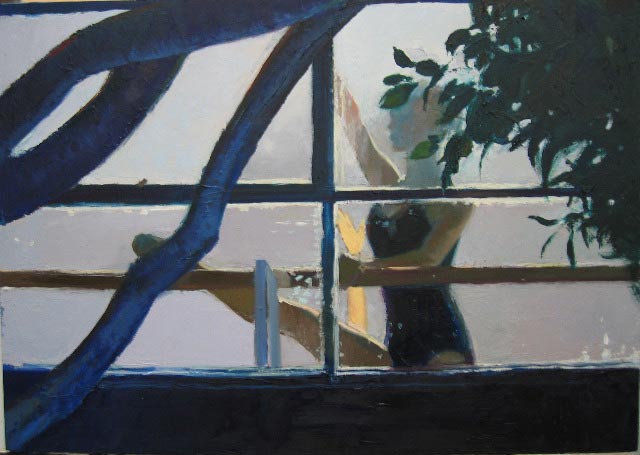 I'm not sure now what made me want to see Stanley Goldstein's show. Some image must have caught my eye. Looking over the Website now, and trying to think back on the show, I can't imagine what that was. I actually completely forgot the entire exhibition almost while I was looking at it. It's not bad; it's just not really anything. I can't say a lot about it. It's, like, motel room art.
I'm not sure now what made me want to see Stanley Goldstein's show. Some image must have caught my eye. Looking over the Website now, and trying to think back on the show, I can't imagine what that was. I actually completely forgot the entire exhibition almost while I was looking at it. It's not bad; it's just not really anything. I can't say a lot about it. It's, like, motel room art.
Is that an insult?
Can I temper it by saying at least Stanley isn't
Salvatore Federico
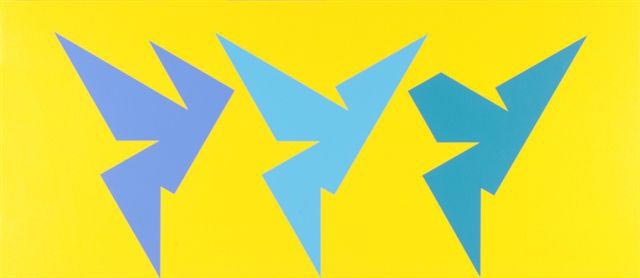 "You know, sometimes I think it'd be so nice," Stephanie said, upon viewing Salvatore Federico's paintings, "It'd be so nice to be an abstract artist. You get up in the morning, tape off a section of canvas, fill it in, and you're done for the day."
"You know, sometimes I think it'd be so nice," Stephanie said, upon viewing Salvatore Federico's paintings, "It'd be so nice to be an abstract artist. You get up in the morning, tape off a section of canvas, fill it in, and you're done for the day."
I agree. I could never do that, day in and day out, without my final work being what hits the canvas after I shoot myself in the head, but on the days when painting goes badly, the idea of being able to just mark off geometric shapes and color them in is so tempting.
Also in 511 is the Robert Steele Gallery, which was showing
Carole Robb
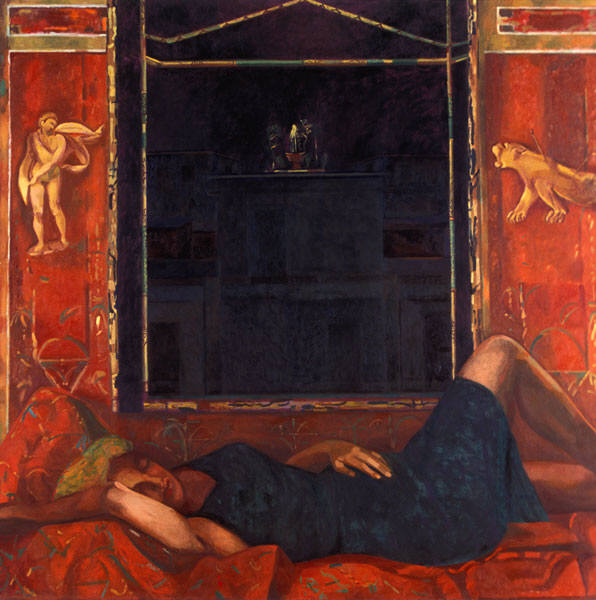 Carole Robb is another artist I can't say a lot about. Her work looked kind of interesting online, and it looked slightly less interesting in person. Women, sphinxes, Greco-Roman decorations, it went in my eyes, sat in short-term memory, and then got lost. But standing in the back of the gallery was a really fantastic work by
Carole Robb is another artist I can't say a lot about. Her work looked kind of interesting online, and it looked slightly less interesting in person. Women, sphinxes, Greco-Roman decorations, it went in my eyes, sat in short-term memory, and then got lost. But standing in the back of the gallery was a really fantastic work by
Josh Garber
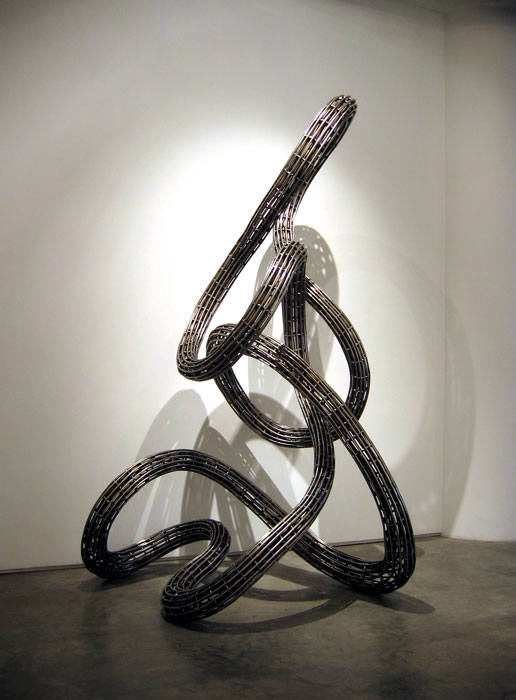 Josh Garber's dynamic steel sculpture, Aloft, simply stole the whole gallery. It's vibrant and exciting and just really, really cool. Like a crazed rollercoaster or insane Hot Wheels track. You look closely and you see two layers of steel tubing welded into a skeleton-like framework; step back and it twists all around itself. It's Giger and it's minimal and it's fast.
Josh Garber's dynamic steel sculpture, Aloft, simply stole the whole gallery. It's vibrant and exciting and just really, really cool. Like a crazed rollercoaster or insane Hot Wheels track. You look closely and you see two layers of steel tubing welded into a skeleton-like framework; step back and it twists all around itself. It's Giger and it's minimal and it's fast.
Eventually we made our way upstairs to see Michael Lyons Wier, like I always do, and also Valerie McKenzie, because I love her. I've already reviewed both of their shows; Stephanie totally fell in love with Julie Allen's work, apparently having more of a context for it than I did. Stephanie and Valerie walked around the gallery several times discussing and praising the work while I trailed behind, woefully left out. Lyons Wier-Ortt has Amanda Besl coming up, and McKenzie Fine Art will have a group show, World without End; both look worth a trip.
We left 511 and went around the block to 26th Street, back to the building with the old manual elevator, to see
Anne Thompson
 at Hudson Franklin. Again, I'm not sure what I saw online that made me think I wanted to see Anne Thompson's paintings, but she was on my list, so we went in. Stephanie almost immediately needed to leave because the paintings made her dizzy. I had to agree; while they weren't as inventive or insanely complex as Susie Rosmarin, Anne's paintings are indeed likely to induce headaches. Susie's work is mostly about geometry and less about color; Anne's work is all about color, and how clashing hues and mismatched patterns can affect perception. Neat Op Art. And to one side Anne had two absolutely massive sheets of paper carefully filled with curious symbols, like some giant Rosetta Stone in an unknown cuneiform. Also neat. Not too exciting, but good if you like that kind of thing.
at Hudson Franklin. Again, I'm not sure what I saw online that made me think I wanted to see Anne Thompson's paintings, but she was on my list, so we went in. Stephanie almost immediately needed to leave because the paintings made her dizzy. I had to agree; while they weren't as inventive or insanely complex as Susie Rosmarin, Anne's paintings are indeed likely to induce headaches. Susie's work is mostly about geometry and less about color; Anne's work is all about color, and how clashing hues and mismatched patterns can affect perception. Neat Op Art. And to one side Anne had two absolutely massive sheets of paper carefully filled with curious symbols, like some giant Rosetta Stone in an unknown cuneiform. Also neat. Not too exciting, but good if you like that kind of thing.
After that we tried to go see Toshio Iezumi at Chappell Gallery; alas, the show had closed, so all we could do was eyeball what we could through the gallery's glass door. Toshio's glass sculptures looked beautiful even from our distance. We were sorry we missed the show.
Next up was a show we were sorry not to have missed, namely
Dawn Mellor
I think I just have to accept that whoever's running things over at Team Gallery and I would not get along. This is the second show I've seen there where the art was so dreadful, so crass -- I've seen a lot of art in Chelsea which was not, to my mind, very good, but generally I feel, if that's what you want to make, then make it. If sculpting poodles out of aluminum and Cracker Jacks is your idiom, then by all means go for it. I don't want or need to see it but then I don't have to. But this is the second time at Team I've seen paintings where I wish someone would talk to the painter and convince them to take up a profession where they can't do any more damage, like chimney sweeping or dry cleaning. I really think the world would be a better place if people like Lisa Ruyter and Dawn Mellor would stop painting.
 Dawn's paintings are just plain ugly. Nasty, stupid, shallow, worthless -- even to compare these paintings to crap would be unfair to crap, which after all has its uses. One denizen of a painting had a fistful of paintbrushes shoved up their ass, and I honestly can't find a better metaphor for what I thought of these works. I want to put the word "art" in quotes when discussing them. They're hateful and awful. Now, you might be saying, but Chris, the name of the show is We Hope You Choke. What were you expecting? Good question.
Dawn's paintings are just plain ugly. Nasty, stupid, shallow, worthless -- even to compare these paintings to crap would be unfair to crap, which after all has its uses. One denizen of a painting had a fistful of paintbrushes shoved up their ass, and I honestly can't find a better metaphor for what I thought of these works. I want to put the word "art" in quotes when discussing them. They're hateful and awful. Now, you might be saying, but Chris, the name of the show is We Hope You Choke. What were you expecting? Good question.
Art doesn't have to be pretty. It doesn't have to be pleasant. Art can be angry and ugly. But art has to be adult. It has to have maturity. A childish tantrum isn't art. An adolescent stomping her foot and slamming her bedroom door isn't art. And Dawn Mellor's paintings are just that, in paint. Puerile hissy fits frozen forever in polymerized vegetable resin so we can look at them and think, "Grow up, loser."
Team's Website asks this question of Dawn's work: "Is this a mature or appropriate response to the problems at hand? An answer in a roundabout way might be provided by a return to the initial moment of the punk formation...." What the dopes at Team fail to realize: The Ramones and the Clash didn't have MAs from the Royal College of Art.
Stephanie was immediately turned off, of course, and made dismissive noises about student-level work. We migrated into the back room. For a moment we stood there talking. Stephanie was telling some story about a gallery director she'd worked with and the room was very quiet because we had Team almost entirely to ourselves. The room was cool and far from the street. I could hear Stephanie really clearly for the first time that day and so I listened, trying to enjoy this moment.
Stephanie stopped midsentence and said, "Can we leave this place?"
She was right. The paintings actually oppress the space in front of them. Just standing there we felt like we were being bombarded with radioactive badness.
Lucky for us our best stop was our last stop: We visited Ed Winkleman and ended up talking to him for almost half an hour. And not about art -- about politics. It was a good way to wrap up the day.


I don't get the impression that the brothers Clayton are angry. I think their imagery is inspired by childhood fears. Fear of laundry? The laundromat can be a scary place for a child. Just sit back and observe all the strange characters that come and go. That's the world of the Clayton brothers.Side note: Chris, I'll be in the city everyday for the month of June. If you want to visit some galleries, let me know.
My feeling from the Clayton Brothers is, yes, they're playing with childhood fears -- good point, by the way -- but they also seem really pissed off. I guess fear and anger can be close emotions.I didn't get a lot of childhood feeling from this show, though. I remember seeing some of their paintings in a group show a few years back, and those were all about how being a kid just sucked. My impression from those was that the Clayton Brothers had serious issues.Re: side note: I'll be in touch. I'm actually planning on being in Philadelphia tomorrow and I'm going to see your show.
I really liked Judy Glantzman's show. I thought it deliciously obsessive, entrancingly quirky and I loved all the faces and heads careening wildy about. But I thought what you wrote was FUNNY even if you were WRONG. Gallery Henoch? Schlock, schlock, schlock!! Anyone imitating Lucien Freud is a dummy, because you can't top him at this own game.
I wouldn't say Stephen Wright is imitating Freud. He's just edging into his territory a bit, and only in one or two paintings, maybe. At this point it'd be hard to paint figures and not look like you're imitating Freud. It'd be like doing Cubism without imitating Picasso.
Hi Chris, I'm giving you a hard time, but please know that I really enjoy reading your blog. We DO often agree!
I like this new Rebel Belle persona. Much more confrontational. Stick with it.
I'm assuming that these comments were made because of exhaustion rather than, say, because of willful ignorance or because you're stupid:"It'd be so nice to be an abstract artist. You get up in the morning, tape off a section of canvas, fill it in, and you're done for the day." "I agree. I could never do that, day in and day out, without my final work being what hits the canvas after I shoot myself in the head, but on the days when painting goes badly, the idea of being able to just mark off geometric shapes and color them in is so tempting."You think it's as simple as that? What idiots!
You think it's as simple as that? What idiots!I will say that not all abstract art is simple. However, Federico's abstract art is.
well this might not get read as i notice this thread has stopped.I really like Freud's work, and I have seen a fair amount of shows of it.In my humble opinion Stephen Wright is not only to influenced by the master he needs to find a way to find his own voice.But they are nice paintings in there own right. I like them although I can only see them on line.Philip Pearlstein comes to mind.some british based painters to check out:Tai-Shan SchierenbergPaula RegoStuar Pearson Wright
I'm such an egotist I have Blogger set to e-mail me any posts so I don't miss a single one. So everything gets read.I've seen both Freud and Wright, obviously. I'm not Freud expert -- especially when talking about his earlier work -- but from what I've seen, Wright's work is fairly different. Freud uses a lot of impasto, nearly sculpting his figures out of paint. He also invests a lot of emotion in his paintings (which I tend to feel is negative; he doesn't strike me as a happy person who likes people). Wright's work is by and large not nearly as impasto and much more sympathetic.That said, Wright's work is also less interesting. His paintings look more like straight-ahead portraits, where Freud's clearly done something, the way John Singer Sargent does.You may need to see Wright in person to really feel the difference.I looked up these other artists you mentioned: They're all interesting. Paula Rego is especially intriguing, because her art has changed so much over the years, and also because her more recent works look really cool.
well he is the grandnephew of Sigmund,I think his mother was Freud's sister...I think hes just very Germanic and Anglo,which gives his work that air of coolness.But when you see a real good painting in person it really is something.I think Wright is more like Pearlstienwho has more warmth in his work.Rego is great, she is an amazing artist. Its interesting as she is a good example of how an artist can develop without being a 20 something art star, she was good at an early age but it took her years to get recognition. She really developed and has gotten better with age.
Thanks for the pointer to Philip Pearlstein, by the way. I think I'd heard of him but wasn't very familiar with his work; now I've seen a fair bit online and it's really interesting. I want to see some in person now. He's definitely gone down a road which, like Freud's, is one not far from mine. Or anyway the road I think I'd like to take.
I thought of one more painter, hes the link to Freud, Stanley Spencer,very ecentric english painter.
I was just looking for information on Dawn Mellor, and happened upon your site. As I'm sure you know, Ms Mellor is currently having her 3rd show at Team- i wondered if you planned to have a look at it. I fell like you are missing the point of this work, and I would really encourage you to go see what she has made for this go around. Firstly, Dawn's work seems to me to be about the notion of a failure to fully access the object of desire- the gulf between "the citizen" and "the celebrity" is too great to be breached- it creates an inconclusive circuit of want and need that has no choice but to be relegated to the world of fantasy. Dawn uses the psycho-analytical constructs of narcissism, desire, and the mirror moment in tandem with violence to gain intimacy with her remote subjects....And I find it personally insulting that you would even consider calling Jose Friere a "dope" (I believe that was your word, but I will not bother to go back and verify). Jose is a really brilliant and self made man, and is one of the few dealers in this city who can go toe to toe with anyone on issues of theory, be they pertaining to art, music, film or literature. He's a fantastic person and one of the smartest men I have ever known. And no, I'm not Jose. Ha.
If Jose Friere wrote or commissioned that terrible tripe of an essay for Dawn Mellor's show, then I'm afraid he is a dope.Your theorization here is beside the point: Absolutely none of that theory comes through in Dawn's ugly, awful, worthless work. How does she "gain intimacy with her remote subjects"? Where does that even come from?I didn't know Dawn had another show at Team. Ordinarily I'd say more power to her -- I may not like a person's art, but I understand that people's tastes differ. Dawn is that rare case where I really think this would be a better world if she stopped painting.